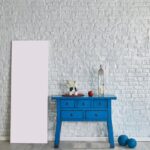How wide is home decor fabric? When it comes to home decor projects, the width of the fabric plays a crucial role in determining the success and efficiency of your undertaking. Understanding different types of home decor fabric and their widths is essential for making informed decisions and achieving desired results.
Home decor fabric encompasses a variety of materials specifically designed for use in decorating homes, including upholstery, curtains, pillows, and more. Different types of fabric have varying widths, which can impact the overall look and functionality of your project. Whether you’re working on a large-scale upholstery project or creating custom drapery, choosing the right fabric width is key to achieving your desired aesthetic and functional goals.
The importance of fabric width becomes especially apparent when working on home decor projects where standard measurements play a significant role in ensuring proper fit and coverage. In this introductory section, we will delve into the world of home decor fabric, explore its different types and widths, as well as discuss why understanding fabric width is crucial for successful outcomes in your home decorating endeavors.
The Standard Width of Home Decor Fabric
Here are some common standard widths of home decor fabric:
- 45 inches: This is one of the most traditional widths for home decor fabric. It is commonly used for smaller projects such as throw pillows, curtains, and small upholstery pieces.
- 54 inches: A slightly wider option that provides more flexibility for medium-sized projects like tablecloths, larger pillows, and some types of draperies.
- 60 inches: One of the widest standard widths available for home decor fabric. This size is suitable for larger projects such as bedding, window treatments, and some furniture upholstery.
The standard width is important because it affects how much yardage you will need for your project. Understanding the average width of home decor fabric can help you calculate the total amount of material required. Additionally, it can impact the overall look and feel of the finished product. For example, using a wider fabric may result in fewer seams in your project, creating a more seamless and polished appearance.
When considering the standard width of home decor fabric, it’s essential to remember that different types of projects require different widths. Understanding how wide is home decor fabric can help you make informed decisions about which width to choose based on your specific project needs. Always consider factors such as pattern repeat, size of the item being constructed, and desired design aesthetic when selecting the appropriate width for your next home decor endeavor.
Factors Affecting Fabric Width
When it comes to the width of home decor fabric, one of the key factors to consider is the manufacturing process. Different fabrics are produced using various methods, which can affect their width. For example, woven fabrics tend to have a standard width due to the nature of their production on looms. On the other hand, knitted fabrics may have more flexibility in terms of width due to their production process.
Additionally, certain fabrics may have limitations in terms of how wide they can be produced. This can be influenced by factors such as the type of fibers used, the machinery available for production, and industry standards for fabric widths. Understanding these manufacturing processes and limitations can help you make informed choices when selecting home decor fabric for your projects.
Another factor that affects fabric width is the influence of trends in the textile industry. Over time, there have been shifts in consumer preferences and design trends that impact the standard width of home decor fabric. For instance, wider fabrics may become more popular due to a growing demand for seamless designs or larger pattern repeats.
Conversely, narrower fabrics might experience a resurgence in popularity as designers seek more versatile options for smaller-scale projects or intricate detailing. Keeping abreast of these trends can help you stay ahead when choosing fabric widths for your home decor projects. Additionally, being aware of upcoming trend shifts could allow you to anticipate changes in availability and pricing for wider or narrower fabric options.
Custom Options for Wider or Narrower Fabric
In some cases, standard fabric widths may not meet your specific project needs. Fortunately, there are custom options available for both wider and narrower home decor fabric. Some manufacturers offer a range of widths outside the standard measurements, allowing you to find the perfect fit for your project.
For those working on large-scale projects that require extra-wide fabric, custom options can provide valuable flexibility and efficiency in material usage. Conversely, if you’re working on a smaller project that demands precision and minimal waste, custom narrow widths might be ideal. Knowing that custom options exist can expand your possibilities when working with home decor fabric and empower you to create unique and tailored pieces for your living space.
Choosing the Right Width for Your Project
When it comes to choosing the right width for your home decor project, there are several important factors to consider. The width of home decor fabric can vary and understanding how wide is home decor fabric can greatly impact the outcome of your project.
One of the first things to understand is the average width of home decor fabric, which is typically around 54 inches. This standard width is important as it allows for more versatility in different projects, such as curtains, upholstery, and bedding.
The standard width of home decor fabric is important for various reasons, one being that it allows for better coverage and less seaming in projects. When using wider fabric, there is less need for sewing multiple pieces together to achieve the desired width, resulting in a cleaner finish and less visible seams. Additionally, with standard widths, there are common sizes and variations readily available in stores and online, making it easier to find what you need for your project.
However, there are some considerations when choosing the right fabric width for your project. Depending on the specific project requirements, such as window size or furniture dimensions, wider or narrower fabric may be necessary.
Understanding how to calculate the amount of fabric needed based on its width is crucial in ensuring that you have enough material for your project without excess waste. It’s also important to consider the drape and texture of the fabric when selecting the right width for different home decor projects.
Widening Your Options
When tackling home decor projects, the width of the fabric plays a crucial role in achieving the desired outcome. Wider home decor fabric offers numerous advantages for certain projects, providing more flexibility and fewer seams. If you’re wondering how wide is home decor fabric, you’ll find that wider options can typically range from 54 to 60 inches, with some specialty fabrics even reaching up to 110 inches in width.
Advantages of using wider fabric for home decor projects include:
- Minimal seams: With wider fabric, you can cover larger areas without having to seam multiple pieces together, creating a seamless and polished look.
- Easier pattern matching: For patterned fabrics, wider options make it easier to match patterns across the project without interruption.
- Efficiency in cutting and sewing: Working with wider fabric reduces the time and effort spent on cutting and sewing multiple pieces together, streamlining the overall process.
If you’re considering using wider home decor fabric for your next project, there are various options available. Many specialty fabric stores offer a wide selection of wider fabrics suitable for different types of projects. Online retailers also provide a vast array of options, giving you access to a diverse range of colors, patterns, and textures in wider widths.
When working with wider fabric in your projects, it’s important to understand how to handle and maneuver the material effectively. Proper cutting techniques and handling methods are essential to ensure precise measurements and clean finishes. Additionally, choosing the right tools such as large cutting mats and rotary cutters can enhance your ability to work with wider fabric seamlessly.
Navigating Narrower Options
When it comes to home decor projects, the width of the fabric you choose can greatly impact the outcome of your project. But just how wide is home decor fabric and when should you consider using narrower options? In this section, we will explore the benefits of utilizing narrow home decor fabric, finding and effectively using narrow fabric, as well as overcoming any challenges that may arise.
When to Use Narrower Fabric for Home Decor Projects
There are certain instances where using narrower fabric for your home decor project can be advantageous. For smaller scale projects such as throw pillows, table runners, or smaller window treatments, narrow fabric can work perfectly without excessive waste. Additionally, if you’re working with a specific design that requires pattern matching or has limited space constraints, using narrow fabric may be the most practical choice.
Finding and Utilizing Narrow Fabric Effectively
When searching for narrow home decor fabric options, it’s important to consider specialty stores or online retailers that cater specifically to home decor and upholstery fabrics. These sources often carry a range of widths including narrower options.
When working with narrow fabric, it’s essential to take accurate measurements and plan your project accordingly to minimize waste and optimize the use of the fabric. Additionally, exploring creative sewing techniques such as piecing or creating seam allowances can help make the most of narrower fabrics.
Overcoming Challenges With Narrow Fabric
While there are certainly benefits to using narrow home decor fabrics, there are also some challenges that may arise. One common challenge is pattern placement and matching on smaller pieces of fabric. This requires careful planning and potentially adjusting your design to accommodate the limitations of a narrower width. Additionally, managing seam allowances on narrower pieces may require additional precision in cutting and sewing to achieve a professional finish.
Case Studies
Visual examples and explanations of projects using wide, standard, and narrow fabric: When it comes to home decor projects, the width of the fabric used can have a significant impact on the final outcome. For instance, wider fabric may be ideal for larger items such as curtains or duvet covers, while narrower fabric may be more suitable for smaller items like throw pillows or table runners.
Lessons learned and best practices: One case study involved creating curtains for a spacious living room. The designer opted for wider home decor fabric, which not only simplified the sewing process but also resulted in seamless panels with minimal seams. This case study serves as a prime example of how wider fabric can streamline the sewing process and create a polished look for large-scale projects.
Another case study focused on crafting throw pillow covers using narrow home decor fabric. Despite initially facing challenges due to limited width, such as aligning patterns and minimizing waste, the designer successfully overcame these obstacles by strategically planning the layout before cutting the fabric. Ultimately, this project demonstrated that with careful consideration and planning, narrower fabric can be utilized effectively for smaller-scale home decor items.
| Projects | Fabric Width |
|---|---|
| Curtains | Wider Fabric |
| Throw Pillow Covers | Narrower Fabric |
Conclusion
In conclusion, understanding the width of home decor fabric is crucial for making informed choices in your home decor projects. The standard width of home decor fabric varies and is an important factor to consider when planning your next project. Factors such as manufacturing processes, trends, and custom options also affect the width of home decor fabric available in the market.
When choosing the right width for your project, it’s essential to consider various factors such as the type of project, design considerations, and how the fabric will be used. Calculating the amount of fabric needed based on the width is also an important aspect to keep in mind. By carefully considering these factors, you can select the best width for different home decor projects.
In today’s market, there are wider options available for certain projects that come with their own set of advantages. Additionally, narrower options can also be effectively utilized depending on the specific requirements of a project.
Understanding how to work with wider and narrower fabric is essential for achieving successful results in your home decor projects. Therefore, by assessing your needs and considering all available options wisely, you can ensure that you make informed choices when selecting the right fabric width for your next home decor project.
Frequently Asked Questions
What Is the Width of Furnishing Fabric?
The width of furnishing fabric can vary depending on the type and intended use. Generally, it can range from 54 inches to 60 inches wide, but some specialty fabrics may be even wider or narrower.
What Is the Standard Width of Fabric?
The standard width of fabric is typically around 54 inches in most cases. This is a common width for various types of fabric, including cotton, linen, polyester, and more. It allows for versatility in its use for different projects.
What Is the Average Width of Upholstery Fabric?
The average width of upholstery fabric tends to be wider than standard fabric widths. Upholstery fabric usually ranges from 54 inches to 60 inches wide to accommodate the size and needs of furniture upholstery projects. This broader width helps cover large pieces efficiently without requiring many seams.

I’m thrilled to be your companion on this exciting journey through the world of home decor and design. With a passion for turning houses into homes and a keen eye for the finer details, I’m here to help you transform your living spaces into beautiful, functional, and meaningful havens.





